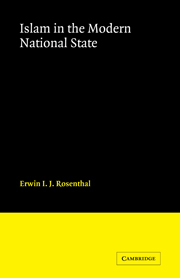Book contents
- Frontmatter
- Contents
- Introduction
- Acknowledgements
- Abbreviations
- Note on transliteration
- PART I CONTEMPORARY ISLAM IN CRISIS AND TRANSITION
- PART II ISLAM IN THE MODERN NATIONAL STATE
- SECTION I CONSTITUTIONAL ISSUES
- 8 The Islamic Republic of Pakistan
- 9 Islam in Malaya
- 10 Some observations on Islam in Iran and Turkey
- 11 Islam in Tunisia and Morocco
- SECTION 2 CHANGES IN LAW AND THE EMANCIPATION OF WOMEN
- SECTION 3 THE PLACE OF ISLAM IN NATIONAL EDUCATION
- Epilogue
- Notes
- Select Bibliography
- Index
10 - Some observations on Islam in Iran and Turkey
Published online by Cambridge University Press: 05 September 2013
- Frontmatter
- Contents
- Introduction
- Acknowledgements
- Abbreviations
- Note on transliteration
- PART I CONTEMPORARY ISLAM IN CRISIS AND TRANSITION
- PART II ISLAM IN THE MODERN NATIONAL STATE
- SECTION I CONSTITUTIONAL ISSUES
- 8 The Islamic Republic of Pakistan
- 9 Islam in Malaya
- 10 Some observations on Islam in Iran and Turkey
- 11 Islam in Tunisia and Morocco
- SECTION 2 CHANGES IN LAW AND THE EMANCIPATION OF WOMEN
- SECTION 3 THE PLACE OF ISLAM IN NATIONAL EDUCATION
- Epilogue
- Notes
- Select Bibliography
- Index
Summary
IRAN
A constitutional régime was set up in Iran in 1906 with the granting of a constitution to which was added in 1907 a number of fundamental laws. Article I declares Islam (that is, Islam according to the tenets of the Shīʿī sect of the Jafarite Ithna Ἁsharī which the Shahinshah (emperor) must profess and propagate) the official religion of Iran. Article II specifies that the Legislative Assembly (majlis) can at no time contradict the Holy Islamic prescriptions nor the laws made by the prophet. The Assembly owes its existence to the expected—last or twelfth—Imam, to His Majesty the Shahinshah of Islam under the supervision of the ‘ulamā, and to the whole Iranian nation. For this purpose a committee of five of the most learned ‘ulamā must be established to watch that all the laws promulgated by the Assembly are, in fact, in accord with Islamic law. They must also be aware of the exigencies of the time. They are to be chosen from among twenty suggested to the Majlis by the ‘ulamā themselves, by unanimity or a ballot of the Assembly. They are full and equal members of the Assembly. The decisions of this committee are final and binding. This Article cannot be modified until the reappearance of the Mahdī, the twelfth Imam. In 1949 the Constituent Assembly voted a procedure for the revision of Articles of the Constitution, but explicitly exempted this Article II from such a revision.
- Type
- Chapter
- Information
- Islam in the Modern National State , pp. 307 - 315Publisher: Cambridge University PressPrint publication year: 1965



